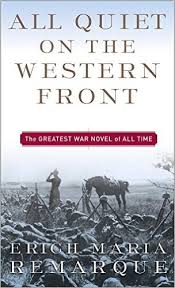Book Review: All Quiet on the Western Front by Erich Maria Remarque
We open on a good day for Paul Bäumer and the men of the Second Company. The sun is shining, there’s a light breeze to cool them, and they’re getting double rations. The reason the men are getting double rations is that half their company was killed in the last action at the front lines, and the supplies were ordered before that was known. But hey, at least their bellies are full for a change.
A few months ago, Paul and his classmates were idealistic young patriots, who signed up for the army en masse at the urging of their schoolmaster. War seemed a glorious adventure then, and they wanted to serve their country. Too late, Paul has realized that old men start the wars that young men die in.
This novel was published in 1928 as Im Westen Nicht Neues (“Nothing New in the West”). It’s based in large part on the actual experiences Mr. Remarque had during his service for Germany in World War One. (Compare Shigeru Mizuki’s Onward Towards Our Noble Deaths, which I have previously reviewed.) It quickly became a bestseller, not only in Germany but around the world for its gut-wrenching picture of the lives of ordinary soldiers. About the only people who didn’t appreciate it were the Nazis, who banned the book when they came to power.
Although there are small moments of individual heroism (and cowardice) in battle, this is not a book where the main characters contribute to a major victory or have the influence to come up with brilliant tactics. At best, they gain a few feet to another set of trenches, and more often, they die to no purpose.
Gritty realism is the main focus here, detailing how the soldiers become desensitized to body modesty, sexual mores and lice. The extreme violence of war can still get to them, though. One of the most memorable scenes is when Paul is trapped in a shellhole with a French soldier who’s taken a mortal wound, but doesn’t die for hours, and how Paul’s emotions change over those hours.
On Paul’s rare leaves, he feels detached from the civilians he’s fighting for, who do not understand the horror of the front lines. But the civilians are suffering too; the bread made from actual bread ingredients Paul brings home is much appreciated, and his mother is dying of cancer. Paul and his fellow soldiers realize well ahead of the civilians that the war is being lost; the leaders are still talking about victory even as the Americans enter the fray.
Although there are deaths in the first part of the novel, the last third increases the pace of mortality as the Second Company falls one by one. The breaking point for Paul is the death of old veteran Katczinsky, who mentored him and the other new recruits in the arts of survival and scrounging. And then comes the end; the book has been told from Paul’s viewpoint until the final page, which is an anonymous postscript telling us Paul is dead.
There are bits of dark humor scattered throughout; one of the more amusing scenes from a schadenfreude perspective is when the schoolmaster who talked Paul and his classmates into enlisting is himself drafted into the Territorial Reserves. His drill master is one of his old students, who delights in throwing the teacher’s motivational speeches back at him.
As one might expect, there’s a certain amount of crude speech from the soldiers, and the usual disturbing events that surround war.
This book is indeed one of the classics, particularly in the field of war literature, and is worth reading at least once, preferably before signing up to go off to war.
Here’s a scene from the 1930 movie version:


Reading your review makes me want to read the book. Have seen the movie but never read the story. Thank you.
You’re welcome!